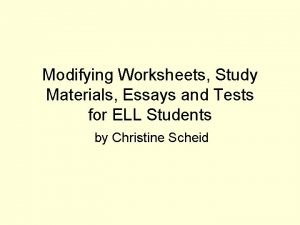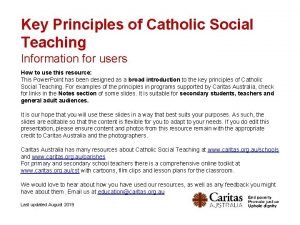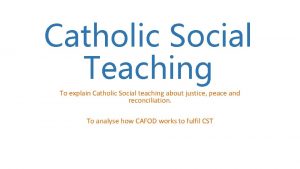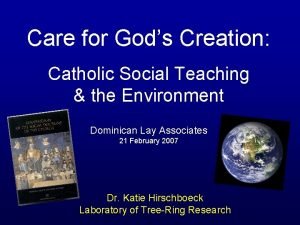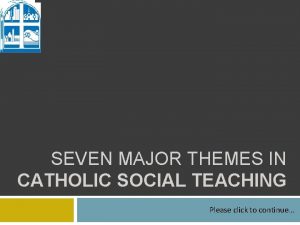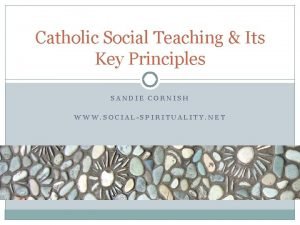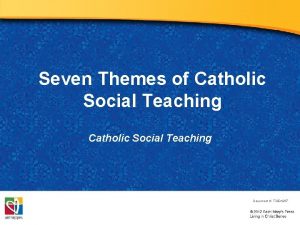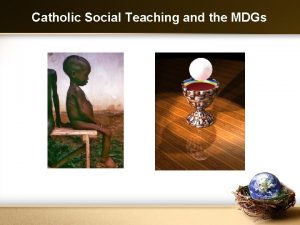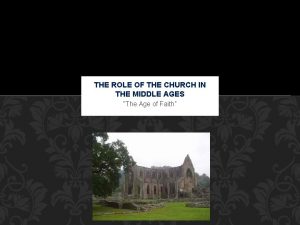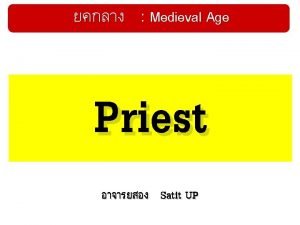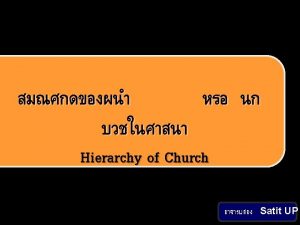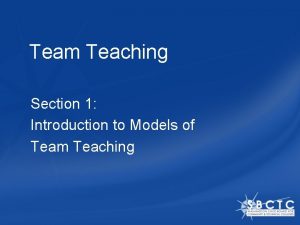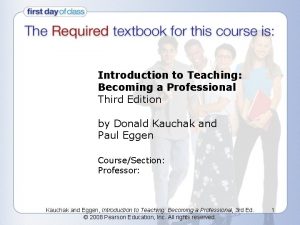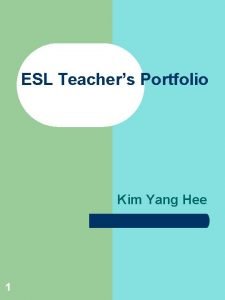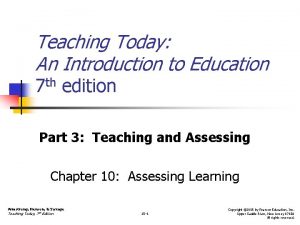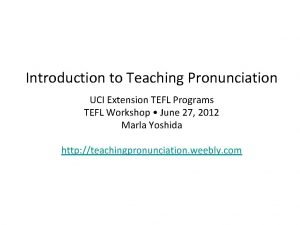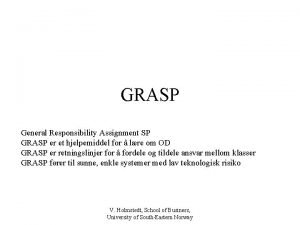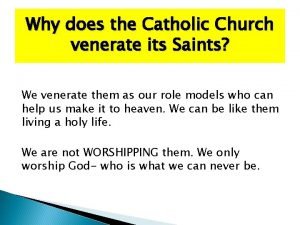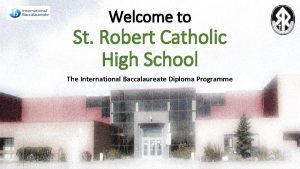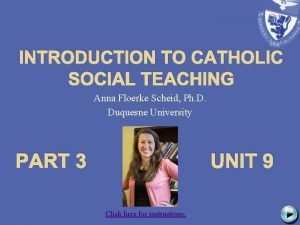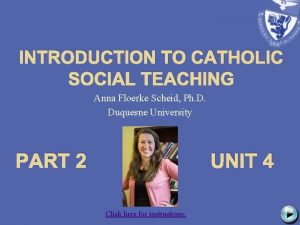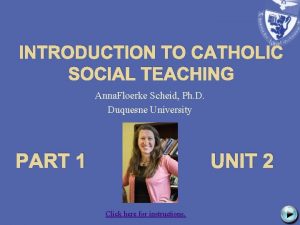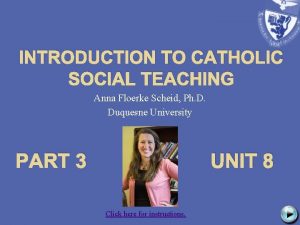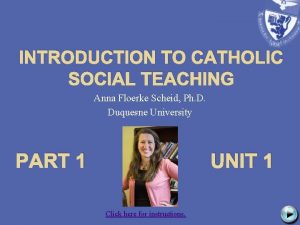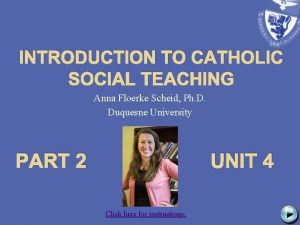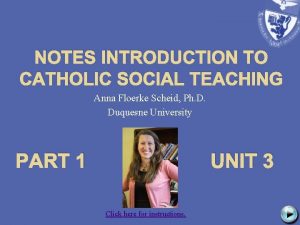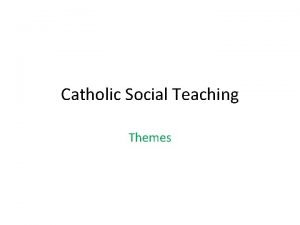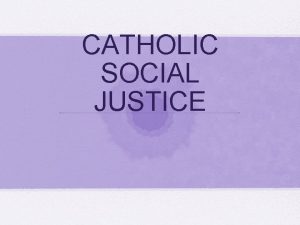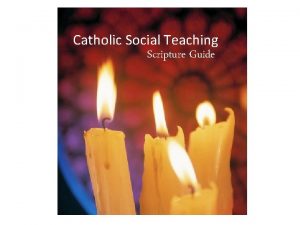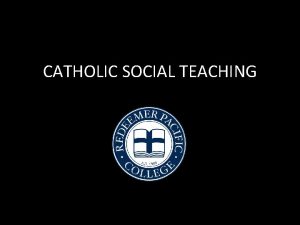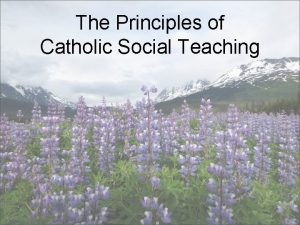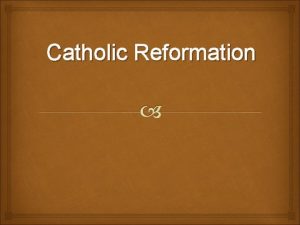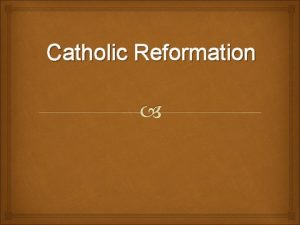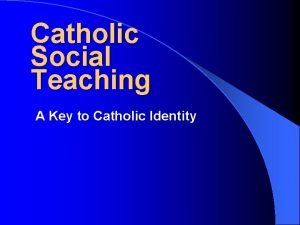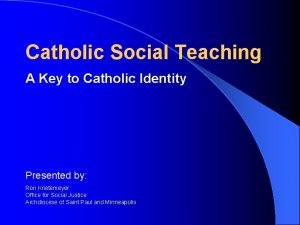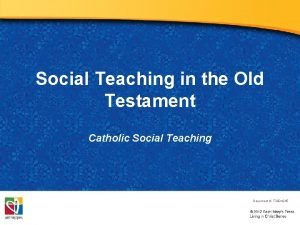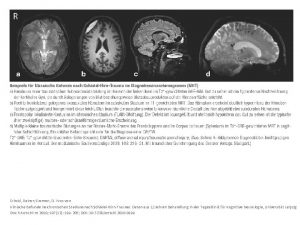INTRODUCTION TO CATHOLIC SOCIAL TEACHING Anna Floerke Scheid



























- Slides: 27

INTRODUCTION TO CATHOLIC SOCIAL TEACHING Anna Floerke Scheid, Ph. D. Duquesne University PART 2 UNIT 5 Click here for instructions.

Instructions Navigation through the course will occur by clicking on the following action buttons located in the lower right corner of each screen: The HOME button will be placed in the center of each slide and will bring you to the Table of Contents for further navigation. The NEXT and BACK buttons will move you through the course content. The EXIT button will be placed at the end of each Unit and will return you to the course menu.

Instructions q This course is meant to be self-paced, though there will be opportunities to interact with your local and global JPIC groups. q Course content and activities should be completed in the order that they are presented to maximize student success. q The Table of Contents will be your starting point for each Unit

Activity Icons Each type of course activity has a unique icon located in the upper right corner of the screen. In this course you will: Create doc Local discussion Global discussion Reflect Read online Watch video Quiz/test Online journal

PART 2: UNIT 5: THE OPTION FOR THE POOR AND VULNERABLE

UNIT 5 TABLE OF CONTENTS This unit is divided into several components. Start with the About This Unit OR click on the link below to navigate to the component where you left off. Revisit as needed. q Instructions q About This Unit q Aims of the Unit q What You Will Learn q 5. 1 Reading: Matthew 25: 31 -46 q 5. 2 Reading: Economic Justice for All q 5. 3 Notes and Critical Concepts q 5. 4 Reflection and Discussion q Unit Summary

What is this unit about? This unit deals with a second foundational theme for Catholic social thought – the option for the poor and vulnerable. In some literature, this is referred to as the “preferential option for the poor. ” CST affirms the special friendship that Jesus Christ developed with the poor and marginalized in historical context, and calls on Catholics to consider the needs of the poor and vulnerable in all of their decisions.

Aims of the Unit By the time you are finished with this unit, you should: q q q Be able to give a clear definition of the preferential option for the poor and vulnerable Be able to explain how the preferential option for the poor and vulnerable emerges from Scripture and the ministry of Jesus Be able to apply and uphold the preferential option for the poor and vulnerable in your own context

What You Will Learn q The context and methodology of the U. S. Bishops’ document Economic Justice for All q The content of the preferential option for the poor: What is it? q Objectives formulated by the U. S. Bishops for upholding the preferential option for the poor in the U. S. context as a good example for applying this principle in a local context

5. 1 READING: THE BIBLE

Reading Click here to complete the reading. Read Matthew 25: 31 -46.

5. 2 READING: ECONOMIC JUSTICE FOR ALL

Reading Click here to complete the reading. Read Economic Justice for All: Chapter 1, par. 16 and Chapter 2, par. 86 -90.

5. 3 UNIT FIVE NOTES AND CRITICAL CONCEPTS

Economic Justice for All q The U. S. Bishops’ Conference of the 1980 s discussed moral issues related to Marxism. They felt it was time for a pastoral letter dealing with the moral issues that arise as a result of capitalism. q The Bishops met with a wide array of people with various kinds of expertise: theologians, economists, politicians, business leaders, farmers, etc.

Economic Justice for All q All drafts of the document were made public and open to comment in order to bring as many people as possible into the discussion. q The document aimed to relate principles of CST to the U. S. economic context at the time.

Economic Justice for All q The document addresses both Catholics and the broader U. S. American public. It appeals to Scripture and Catholic Tradition, but also to Natural Law and even to key American ideals/principles such as “equality, ” “opportunity, ” and “justice for all. ” For example, early in the document, the Bishops note that “We bring to this task [of assessing the moral problems related to capitalism] a dual heritage of Catholic social teaching and traditional American values” (Prologue, par. 7).

Economic Justice for All The document asserts that economic activity has moral content, and the Bishops include a call to conversion toward economic activity that promotes the common good, including the good of the poor. For example: “Followers of Christ must avoid a tragic separation between faith and everyday life. . Economic life is one of the chief areas where we live out our faith, love our neighbor, confront temptation, fulfill God’s creative design, and achieve our holiness” (Prologue, par. 5 -6); and “We cannot separate what we believe from how we act in the market place and the broader community” (Prologue, par. 25).

Economic Justice for All There is a real concern that Catholics understand that it isn’t enough to go to Church or say prayers. Instead, conversion – a total examination of values and how those values are enacted in everyday life – is required.

The Preferential Option for the Poor and Vulnerable q The U. S. Bishops call the preferential option for the poor and vulnerable a “fundamental moral criterion for all economic decisions. [These decisions] must be at the service of all people, especially the poor” (Ch. 1, par. 24). q The preferential option for the poor and vulnerable is a moral principle and can be expressed in the following way: all decisions – whether the personal decisions of individuals or social decisions made by legislatures or representatives – should be made in light of how they affect the poorest and most vulnerable among us; no decision should be made that harms the poorest and most vulnerable among us.

The Preferential Option for the Poor and Vulnerable q Thus, the preferential option for the poor and vulnerable involves what the U. S. Bishops call a “special commitment” to not only helping the poor or meeting their basic needs, but also to empowering the poor so that they are better able to meet their own needs. q Note the emphasis on the idea that charity is good and important but is not the solution to all social ills; we also need to work toward justice, especially through the empowerment of the poor.

5. 4 REFLECTION AND DISCUSSION

Reflection and Discussion Reflect on the following two questions in your course journal. Post all or portions of your reflection to the discussion board. Read others’ reflections and respond.

Reflection and Discussion 1) In the passage you read from the gospel of Matthew, Jesus describes a King with all the “nations” gathered before him. The King separates the nations into “sheep-nations” and “goatnations” based on their actions on behalf of the vulnerable. What is the significance of the fact that Jesus does not speak of individuals gathered and separated, but of “nations”? What is the relationship between the individual person and the community, especially when it comes to moral development and the responsibility to care for the vulnerable?

Reflection and Discussion 2) Imagine that the Bishops in your own local context are going to write a letter addressing the problem of poverty in your part of the world today. a) How would they describe poverty? What social demographics are most likely to be poor? What is the percentage of the poor compared to the rest of the population? How should poverty be defined? b) What theological issues related to poverty would need to be addressed? How does poverty affect the dignity of those who are poor? How does the community address or fail to address poverty in accordance with Jesus’ words from Matthew 25? c) What key issues or strategies for empowering the poor might emerge?

Unit Summary In Unit 5, you learned the meaning of the preferential option for the poor and vulnerable. You saw how this principle emerges from Scriptural passages such as Matthew 25 and how it was applied in the 1980 s by the U. S. Bishops in their local context. You also had the opportunity to consider how it might be applied in your own local context today.

YOU HAVE COMPLETED UNIT 5 Please return to the Table of Contents using the HOME button to review any material or EXIT to the course menu.
 Structural sin
Structural sin Christine scheid
Christine scheid Catholic social teachings
Catholic social teachings Cafod catholic social teaching
Cafod catholic social teaching Catholic social teaching
Catholic social teaching Catholic social teachings care for god's creation
Catholic social teachings care for god's creation Cst themes
Cst themes Principles of cst
Principles of cst Seven key themes of catholic social teaching
Seven key themes of catholic social teaching Catholic teaching on poverty
Catholic teaching on poverty Social structure of catholic church
Social structure of catholic church The catholic church hierarchy pyramid
The catholic church hierarchy pyramid Ranks in the catholic church
Ranks in the catholic church Definition of microteaching
Definition of microteaching Social thinking adalah
Social thinking adalah Social thinking social influence social relations
Social thinking social influence social relations What is team teaching
What is team teaching Introduction to teaching becoming a professional
Introduction to teaching becoming a professional Esl teacher portfolio
Esl teacher portfolio Teaching today an introduction to education
Teaching today an introduction to education Chapter 1 the teaching profession
Chapter 1 the teaching profession Introduction to teaching pronunciation
Introduction to teaching pronunciation Teaching personal and social responsibility
Teaching personal and social responsibility Beliefs of roman catholic
Beliefs of roman catholic Catholic hand gesture
Catholic hand gesture St robert chs
St robert chs Pope paul catholic primary school
Pope paul catholic primary school Catholic last rites prayer
Catholic last rites prayer

